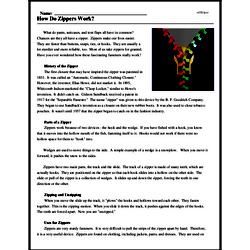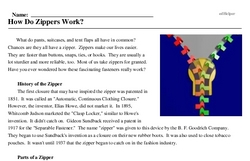How Do Zippers Work?
What do pants, suitcases, and tent flaps all have in common? Chances are they all have a zipper. Zippers make our lives easier. They are faster than buttons, snaps, ties, or hooks. They are usually a lot sturdier and more reliable, too. Most of us take zippers for granted. Have you ever wondered how these fascinating fasteners really work?
History of the Zipper
The first closure that may have inspired the zipper was patented in 1851. It was called an "Automatic, Continuous Clothing Closure." However, the inventor, Elias Howe, did not market it. In 1895, Whitcomb Judson marketed the "Clasp Locker," similar to Howe's invention. It didn't catch on. Gideon Sundback received a patent in 1917 for the "Separable Fastener." The name "zipper" was given to this device by the B. F. Goodrich Company. They began to use Sundback's invention as a closure on their new rubber boots. It was also used to close tobacco pouches. It wasn't until 1937 that the zipper began to catch on in the fashion industry.
Parts of a Zipper
Zippers work because of two devices - the hook and the wedge. If you have fished with a hook, you know that it moves into the hollow mouth of the fish, fastening itself to it. Hooks would not work if there were no hollow space for them to "hook" into.




